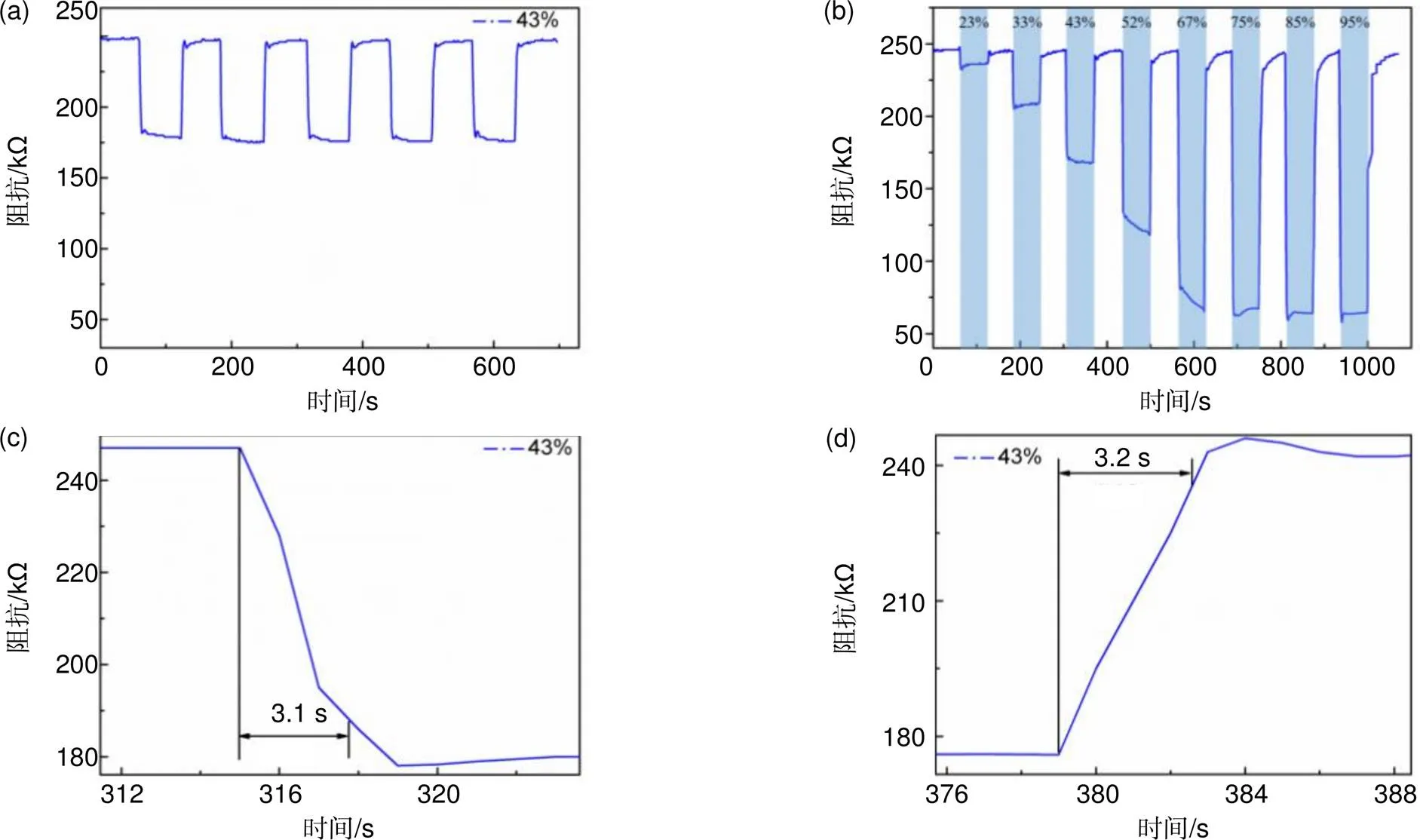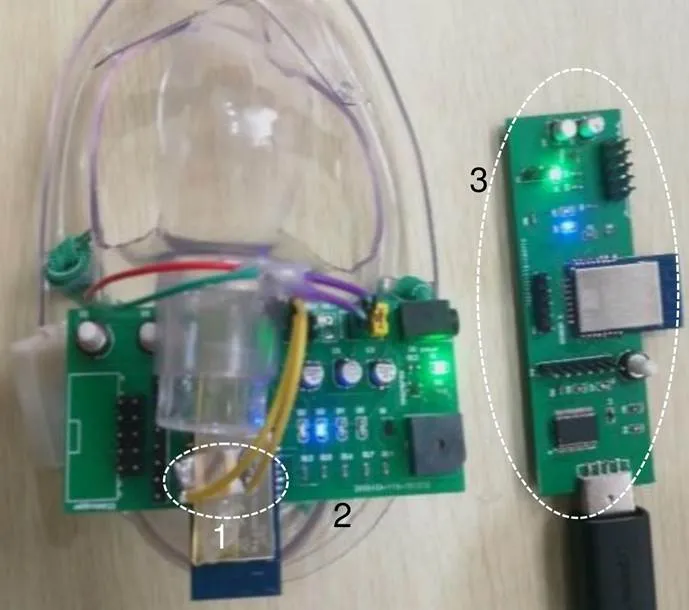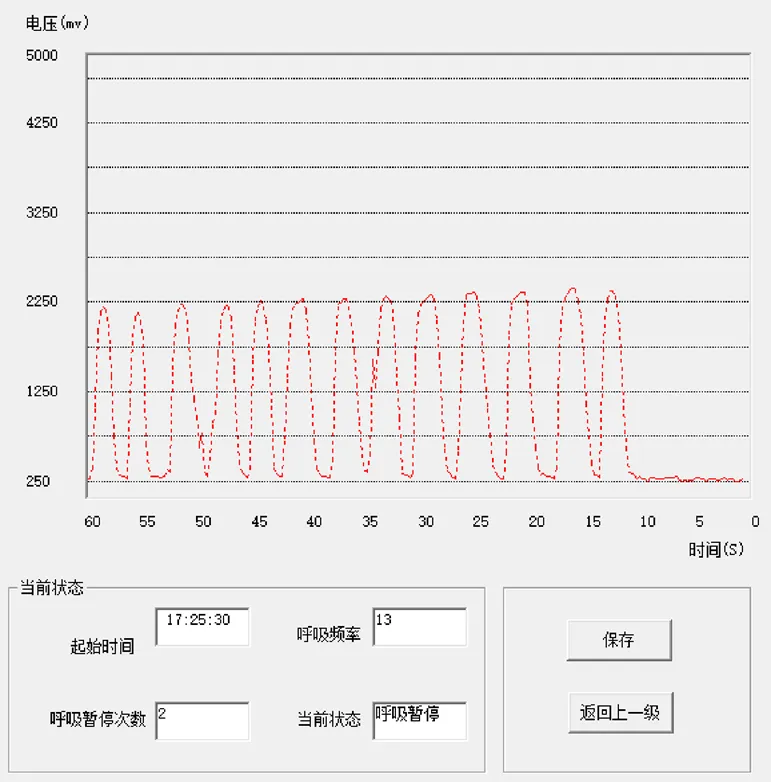基于无机卤化物钙钛矿湿度传感器的呼吸率监测系统
邬映杰,伍志林,王 玲,辇伟奇,何 邕,郭永彩*
基于无机卤化物钙钛矿湿度传感器的呼吸率监测系统
邬映杰1,伍志林1,王 玲2,辇伟奇2,何 邕1,郭永彩1*
1重庆大学光电工程学院光电技术与系统教育部重点实验室,重庆 400044;2重庆大学附属肿瘤医院,重庆 400030
呼吸率检测中存在主观因素强、信号提取复杂、设备不易获取和有线连接不方便测试者移动等问题。人体呼吸周期为3 s~6 s,呼吸气流是呼吸动作的最直接反应,与周围空气存在湿度差。本文采用研制的新型无机卤化物钙钛矿湿度传感器测量呼吸率,克服了市面上湿度传感器响应和恢复时间长(10 s以上)的问题。系统使用Zigbee无线通信传输检测信号,使信号检测和处理部分分离,方便测试者移动。使用上位机软件进行数据处理计算呼吸率,并根据呼吸暂停阈值判断呼吸状态。测试结果表明,系统可实时准确监测呼吸率,最大误差1次/分钟,具有准确率高、信号处理简单、便携和成本低的优势。
呼吸气流;湿度传感器;呼吸率监测;无线通信;上位机设计

1 引 言
呼吸率作为呼吸功能的一个重要参数,指每分钟呼吸次数,可提供与健康状态相关的重要信息。对呼吸率进行持续、准确和稳定的监测,对于预防呼吸道疾病、心血管疾病以及临床监护具有重要意义[1-3]。目前呼吸率可以通过脉搏血氧检测[4-6]、心电图信号和血管容积图检测[5, 7],胸腹腔运动检测[8]等技术进行测量,然而上述技术存在信号提取复杂、检测设备昂贵和主观因素强等问题。呼吸气流是呼吸最直观的反应,通过测量呼吸气流检测呼吸率具有简单、准确的优势,但是常见的气流检测方法,如温度传感器[9]、压电传感器[10]和流量传感器[11],输出信号弱,需要将传感器伸进鼻孔和需要面部密封防止漏气。采用电阻式湿度传感器来检测呼吸气流具有器件体积小、电路结构简单、价格低廉等优点,然而常见的如碳式湿度传感器、高分子聚合物湿度传感器、氧化物陶瓷湿度传感器等电阻式湿度传感器通常存在工作温度高、响应时间和恢复时间较长等缺点,不能满足快速、准确、实时呼吸率测量的要求。随着材料科学的发展,近年来,已有许多将新型材料用于湿度传感测量呼吸信号的文献报道[12-17]。开发基于新型湿敏材料的室温湿度传感器,并设计开发相应的测控电路和数据处理软件构建呼吸检测系统具有重要现实意义。钛酸钡系列钙钛矿材料是常见的电阻式传感湿敏材料,然而要获得较好的多孔结构和敏感性能往往需要复杂制备和高温掺杂烧结过程。近年来,有机无机杂化卤化物钙钛矿材料由于其高环境敏感性及室温载流子高迁移率,在气湿敏传感方面备受关注,然而采用稳定性较高的全无机卤化物钙钛矿制备湿敏传感器尚较少报道。
本文采用铯铅溴全无机钙钛矿膜作为湿敏材料制备电阻式湿度传感器。铯铅溴全无机钙钛矿膜是典型的立方晶体结构,表面富含Br,可以提供载流子通道,更有利于水分子的吸收,对水分子极其敏感。使用这种材料作为敏感材料的湿度传感器,响应速度快、响应大且重复性好,同时这种材料制备工艺成熟,易合成且对环境友好。开发了相应分压电路来精确测量湿度变化,设计了包含湿度传感器、数据采集、无线传输节点、接收节点和呼吸信号处理软件的呼吸监测系统,具有信号强、响应和恢复时间短、结构简单的优势,能够满足实时准确呼吸率检测和呼吸状态监测预警的需求。
2 呼吸监测系统总体设计
呼吸监测系统包含湿度传感器、数据采集、无线传输节点、接收节点和呼吸信号处理软件四个部分,系统总体框图如图1所示。通过湿度传感器将呼吸气流转换成电阻变化,数据采集、无线传输节点通过分压电路将电阻变化转换成电压的变化,再通过AD转换成数字信号。主控芯片采用具备AD转换功能和RF射频无线通信功能的CC2530,具有操作简单,可以快速构建应用的优势。主控芯片将呼吸信号发送到接收节点,接收节点接收来自无线传输节点的呼吸信号后,通过串口转USB将接收到的数据传输到电脑上位机软件,上位机软件计算出呼吸率,判断测试者是否发生呼吸暂停,若发生暂停时,则将呼吸暂停信息显示在界面上。

图1 呼吸监测系统总体框图
3 无机卤化物钙钛矿湿度传感器制作
无机卤化物钙钛矿湿敏材料合成如图2所示。将100 mg碳酸铯(Cs2CO3)、4ml1-十八烯(1-octadecene,ODE)、0.5ml油酸(Oleic Acid,OA)在120 ℃的氮气气氛中搅拌得到澄清Cs-OA溶液。同时,将5 ml ODE,69 mg溴化铅(PbBr2)在120 ℃真空保存1 h,在氮气气氛中加入0.5mlOA和0.5ml油酸胺(Oleylamine,OLAm),待其完全溶解后,迅速注入0.4mlCs-OA溶液,反应5 s后放入冰浴中冷却和结晶,得到铯铅溴卤化物钙钛矿材料。
电阻式湿度传感器制作如图3所示。将无机卤化物钙钛矿湿敏材料在甲苯中分散超声20 min,然后用移液器吸取10微升滴涂在叉指电极上,在100 ℃加热10 min成型,真空下保存24 h稳定器件性能。
4 硬件电路设计
近年来,呼吸信号居家监测和无线传输成为应用趋势[18],本文采用Zigbee无线通信传输采集信号,方便被测试者活动。硬件电路包括数据采集、无线传输节点,接收节点两个部分,框图如图4所示。采用电压转换模块将串联纽扣电池的供电电压转换成3.3 V,为CC2530供电。传感器信号转换电路将呼吸信号转换成电压信号,使用CC2530自带的模数转换功能采集电压信号。CC2530使用串口进行通信,为了便于与电脑之间进行数据传输,采用串口转USB将接收节点数据传输给电脑。

图2 无机卤化物钙钛矿湿敏材料合成
4.1 传感器信号转换电路设计
湿度传感器与精密电阻串联形成分压电路,如图5所示。当呼出气体时,鼻气流湿度增大,湿度传感器电阻变小,其上电压减小,精密电阻两端电压增大。反之,精密电阻两端电压减小,分压电路采用串联的三节纽扣电池供电,精密电阻两端的电压与微处理器模数转换接口连接。

图3 电阻式湿度传感器制作流程图

图4 硬件电路框图

图5 传感器信号转换电路
4.2 电源管理电路
为了携带方便,系统采用纽扣电池供电,将三节1.5 V纽扣电池串联,主控芯片CC2530需要3.3 V供电才能正常工作,因此采用电压转换电路将供电电压转换成3.3 V,电压转换芯片采用TI的TPS797,电源管理电路如图6所示。
4.3 串口转USB电路设计
由于现在大部分终端机为USB接口,为了方便数据传输,需要通过串口转USB将主控芯片的数据传输到终端机中,供上位机软件使用,电脑转USB电路如图7所示。
4.4 硬件电路程序设计
数据采集、无线传输节点首先需要进行系统初始化,包括射频初始化,定时器初始化,ADC初始化。然后打开定时器,开始计时,当时间到达250 ms时,相当于采用频率4 Hz,启动ADC采集呼吸电压信号并进行标度变换转换成电压值。然后将电压值载入射频发送寄存器中,启动射频发送功能,将数据发送给接收节点,流程图如图8所示。
接收节点程序流程图如图9所示。接收节点同样需要首先进行初始化,当收到数据采集、无线传输节点发送的数据时将自动产生射频中断。射频寄存器将接收到数据,然后将寄存器中数据读取出来。通过串口产生中断,将接收到的数据通过串口转USB传输给电脑。
5 软件部分
5.1 上位机软件界面设计
为了方便用户实时观察呼吸曲线和处理后的信息,用Visual Basic制作了用户界面,如图10所示。当计算机接收到呼吸信号后,通过对呼吸信号进行处理,计算出呼吸率,判断是否发生呼吸暂停等,数据可以存储为文件以供进一步分析。
5.2 上位机程序设计
呼吸率通过计算一分钟内出现的呼吸峰值得到,采用峰值提取算法得到每分钟内出现峰值的个数。呼吸暂停判断根据美国睡眠医学会的定义[19]:三次呼吸峰值的均值作为基线,当前呼吸幅值相较于基线下降超过90%,且持续时间超过10 s。上位机程序流程图如图11所示。接收节点通过USB向电脑发送数据,上位机软件首先需要调用串口通信控件,读取出串口通信控件接收到的数据,然后计算出每个呼吸周期的峰值,保存到数组中,当呼吸超过三个周期之后,计算出基线。然后接收到的数据与基线相比较,当判断发生呼吸暂停时,在界面中显示出呼吸暂停。测试超过一分钟之后,开始显示呼吸率。

图6 电源管理电路

图7 串口转USB电路

图8 数据采集、无线传输节点程序流程图

图9 接收节点程序流程图

图10 上位机软件界面

图11 上位机程序流程图

图12 传感器性能测试。(a) 重复性;(b) 梯度湿度;(c) 响应时间;(d) 恢复时间
6 系统测试与分析
无机卤化物钙钛矿湿度传感器制作完成以后需要对传感器的性能进行测试,包括重复性、梯度湿度、响应时间和恢复时间。图12所示为传感器测试性能图。图12(a)为重复性测试,基线湿度为13%,在43%湿度下,重复测试五次,可以看到响应曲线较为一致,传感器重复性较好。图12(b)所示为梯度湿度测试,基线湿度为13%,湿度从23%增至93%,湿度每次增加10%,由于采用饱和盐溶液配制湿度,湿度存在一定误差。随着湿度增加,传感器响应增大,从中可以看到在60%湿度以下时,传感器响应具有较好的线性度。图12(c)所示为传感器从13%湿度移至43%湿度时的响应时间,响应时间为3.1 s。图12(d)所示为传感器从43%湿度移至13%湿度时的恢复时间为3.5 s。一个完整测试循环响应和恢复耗时6.6 s,但是从图中可以看到在响应和恢复的前一半时间内,也就是在3 s内,传感器阻抗已经产生较大变化,具有较短的响应时间和恢复时间,克服了市面上湿度传感器响应和恢复时间在10 s以上的缺点[20],因此该传感器可以通过探测湿度改变用于呼吸信号的检测。

图13 呼吸率监测系统实物。1-湿度传感器;2-发送节点;3-接收节点
本文研制的基于湿度传感器的呼吸率监测系统实物如图13所示。
邀请一位同学佩戴本文研制的呼吸率监测系统,其某一分钟的呼吸监测情况如图14所示。从图中可以直观观察到呼吸曲线,图中共有13个呼吸循环,呼吸频率为13次/分钟,与上位机软件程序计算的呼吸频率一致。当前时刻产生呼吸暂停,与程序判断的呼吸状态一致。

图14 呼吸率监测显示与判断
为了验证本文研制的湿度传感器和监测系统采用的算法对不同个体的呼吸率监测情况,邀请五位测试者进行呼吸测试,为了防止主观因素影响,被测试者戴眼罩,保持均匀呼吸,每位被测试者测试三次,分别测试正常呼吸,快速呼吸和慢速呼吸的频率,每次测试时长一分钟。测试数据如表1所示。
从五位测试者的测试数据可以看到,在快速、慢速和正常呼吸下,系统测试呼吸率与测试者实际呼吸率最大误差为1次/分钟。这是由于本文研制的湿度传感器具有快速响应和响应大的特点,即使在微弱呼吸以及快速呼吸等极端呼吸情况下,依然能够对呼吸气流的变化实时响应,将呼吸循环精确地转换成呼吸曲线变换。使用Zigbee无线传输方式传输数据,工作稳定。采用的峰值提取和动态阈值算法能够实时调整呼吸基线。系统的呼吸率监测误差小,能够较为准确监测呼吸率。
7 结束语
本文设计开发了基于无机卤化物钙钛矿湿度传感器的呼吸率监测系统,能通过呼吸气流湿度变化准确测量呼吸过程,具有结构简单、输出信号大、响应速度快、能耗低、轻便易携等优势,系统的呼吸实测结果准确率高且循环稳定性好。该系统有望在日常呼吸率测量以及医院病人呼吸率监测等众多场景中得到应用。

表1 呼吸率测试
[1] Cretikos M A, Bellomo R, Hillman KRespiratory rate: the neglected vital sign[J].2008, 188(11): 657–659.
[2] Allen J. Photoplethysmography and its application in clinical physiological measurement[J].2007, 28(3): R1–R39.
[3] Hogan J. Why don't nurses monitor the respiratory rates of patients?[J].2006, 15(9): 489–492.
[4] Chen X C, Zhao H, Bi Y G,. Respiratory rate estimation from smartphone-camera-acquired pulse wave signal using visible light[J]., 2017, 38(7): 932–935. 陈星池, 赵海, 毕远国等手机可见光提取脉搏中呼吸率的估计[J]. 东北大学学报(自然科学版)2017, 38(7): 932–935.
[5] Pimentel M A F, Johnson A E W, Charlton P HToward a robust estimation of respiratory rate from pulse oximeters[J].2017, 64(8): 1914–1923.
[6] Chen X C, Zhao H, Li H,. Detection of respiratory rate using pulse wave on near infrared wearable devices[J]., 2016, 24(6): 1297–1306. 陈星池, 赵海, 李晗等近红外可穿戴设备中脉搏波的呼吸率检测[J]. 光学精密工程, 2016, 24(6): 1297–1306.
[7] Charlton P H, Birrenkott D A, Bonnici TBreathing rate estimation from the electrocardiogram and photoplethysmogram: a review[J].2018, 11: 2–20.
[8] Chu T S, Lu M Z, Ma Z X. Respiratory rate measurement based on mattress life monitor[J]., 2014(18): 5–6.储泰山, 陆美珠, 马志新. 基于床垫式生命监测仪的呼吸率检测[J]. 科技创新与应用2014(18): 5–6.
[9] Turnbull H, Kasereka M C, Amirav IDevelopment of a novel device for objective respiratory rate measurement in low-resource settings[J].2018, 4(4): 185.
[10] Lee P J. Clinical evaluation of a novel respiratory rate monitor[J].2016, 30(2): 175–183.
[11] Fan D Y. Improved design and algorithm research of portable respiratory detection system[D]. Tianjin: Tianjin University, 2018.范大勇. 便携式呼吸监测系统设计方案的改进和算法研究[D]. 天津: 天津大学, 2018.
[12] Zhen Z, Li Z C, Zhao X LFormation of uniform water microdroplets on wrinkled graphene for ultrafast humidity sensing[J].2018, 14(15): 1703848.
[13] Smith A D, Elgammal K, Niklaus FResistive graphene humidity sensors with rapid and direct electrical readout[J].2015, 7(45): 19099–19109.
[14] Atalay O, Kennon W R, Demirok E. Weft-knitted strain sensor for monitoring respiratory rate and its electro-mechanical modeling[J].2015, 15(1): 110–122.
[15] Zheng Y L, Ding X R, Poon C C YUnobtrusive sensing and wearable devices for health informatics[J].2014, 61(5): 1538–1554.
[16] Mogera U, Sagade A A, George S JUltrafast response humidity sensor using supramolecular nanofibre and its application in monitoring breath humidity and flow[J].2014, 4:4103.
[17] Borini S, White R, Wei DUltrafast graphene oxide humidity sensors[J].2013, 7(12): 11166–11173.
[18] Adib F, Mao H Z, Kabelac Z ESmart homes that monitor breathing and heart rate[C]//, South Korea, 2015: 837–846.
[19] Iber C, Ancoli-Israel S, Chesson A L[M]. 2nd ed. Westchester, Ill, USA: American Academy of Sleep Medicine, 2012.
[20] Anichini C, Aliprandi A, Gali S MUltrafast and highly sensitive chemically functionalized graphene oxide-based humidity sensors: harnessing device performances via the supramolecular approach[J].2020, 12(39): 44017–44025.
Respiratory rate monitoring system based on inorganic halide perovskite humidity sensor
Wu Yingjie1, Wu Zhilin1, Wang Lin2, Nian Weiqi2, He Yong1, Guo Yongcai1*
1Key Laboratory of Optoelectronic Technology and Systems of Ministry of Education of China, Chongqing University, Chongqing 400044, China;2Chongqing University Cancer Hospital, Chongqing 400030, China

Respiratory rate monitoring system. 1-humidity sensor; 2-send node; 3-receive node
Overview:Respiratory rate, as an important parameter of respiratory function, refers to the number of breaths per minute, and can provide important information related to health status. Continuously, accurately and stably monitoring respiratory rate is great significance for preventing respiratory diseases, cardiovascular diseases. It is simple and accurate to measure breathing rate by measuring the respiratory airflow. However, common airflow detecting methods, such as temperature sensors, piezoelectric sensors, and flow sensors, having weak output signals. There is 30% humidity difference between human exhaled gas with the outside world, humidity sensor can be used to measure the breathing signal. Human breathing frequency from 12 to 20 times per minute. The response and recovery time of the humidity sensors on the market range from ten seconds to tens of seconds, which cannot use to respiratory rate monitoring. When 30% humidity change occurs in the inorganic halide perovskite humidity sensor made in this paper, resistance will change significantly and recover within 3 seconds, which can be used to measure respiratory nasal airflow signals.
For the convenience of testers, this system uses Zigbee wireless network to transmit signals. The system is divided into four parts: sensor, data acquisition and sending node, receiving node, and host computer software. The data acquiring and sending node collects breathing signal converted by the humidity sensor and sends it to receiving node. Receiving node transmits received data to host computer software. The host computer software processes the received data, and compute respiratory rate through the algorithm. After processing, the relevant information is displayed on the interface for reference by medical staff. From the test data of five testers, it can be seen that under fast, slow, and normal breathing, the maximum error between the system test breathing rate and the tester's actual breathing rate is 1 per minute, and the system can accurately monitor the breathing rate.
This article designs and develops a respiratory rate monitoring system based on an inorganic halide perovskite humidity sensor, which can accurately measure the breathing process through respiratory airflow. It has a simple structure, a large output signal, a fast response speed, low energy consumption, and is easy to carry. The advantage is that the system's measured breathing results have high accuracy and good circulation stability. The system is expected to be applied in many scenarios such as daily respiratory rate measurement and monitoring of patient respiratory rate in hospitals.
Wu Y J, Wu Z L, Wang L,Respiratory rate monitoring system based on inorganic halide perovskite humidity sensor[J]., 2021, 48(3): 200100; DOI:10.12086/oee.2021.200100
Respiratory rate monitoring system based on inorganic halide perovskite humidity sensor
Wu Yingjie1, Wu Zhilin1, Wang Lin2, Nian Weiqi2, He Yong1, Guo Yongcai1*
1Key Laboratory of Optoelectronic Technology and Systems of Ministry of Education of China, Chongqing University, Chongqing 400044, China;2Chongqing University Cancer Hospital, Chongqing 400030, China
The traditional respiratory rate measurement technologies have several deficiencies, such as subjective appraised results, complicated signal extraction processes, difficult access to equipment, and inconvenience to move due to the wired connection setting. The respiratory airflow can directly reflect the human breath, and the respiratory frequency is usually 10~12 breaths/min (1 ventilation every 5~6 seconds). The humidity difference between exhalation and inhalation can be directly used to measure respiratory rate. In the present work, a wireless respiratory rate monitoring system based on inorganic halide perovskite humidity sensor was developed. The sensor exhibits an ultrasensitive humidity sensing performance, which overcomes the long response/recovery time (> 10 seconds) of the commercial humidity sensors. The system utilized a Zigbee wireless communication to transmit the measurement signal, which separates the signal detection and processing parts, making it easier for the tester to move. The upper computer software was designed and used for data processing to calculate the breathing rate. The system can accurately monitor the respiratory rate in real-time, recognize and alarm the apnea successfully by comparing with a setting threshold value. The test results show that the system can accurately monitor the breathing rate with a maximum error of 1 time per minute. The system possesses great potential for application in respiratory rate monitoring due to its high accuracy, simple operation, portability, and low cost.
respiratory airflow; humidity sensor; respiratory rate monitoring; wireless communication; upper computer design
National Key R & D Plan for Major Instruments (2016YFF0102802), Chongqing Key Instrument Project (cstc2017zdcy-zdzxX0009), Funded by Special Fund for Performance Incentive Guidance of Scientific Research Institutions in Chongqing (cstc2019jxjl130029), Chongqing Natural Science Foundation (cstc2018jcyjA3233, cstc2019jcyj- msxmX0623), Fundamental Scientific Research Business of Central Universities (2018CDQYGD0008, 2018CDXYGD0017, 2019CDQYGD004), and Chongqing Graduate Research and Innovation Project (CYS19011)
10.12086/oee.2021.200100
TH837
A
* E-mail: ycguo@cqu.edu.cn
邬映杰,伍志林,王玲,等. 基于无机卤化物钙钛矿湿度传感器的呼吸率监测系统[J]. 光电工程,2021,48(3): 200100
Wu Y J, Wu Z L, Wang L,Respiratory rate monitoring system based on inorganic halide perovskite humidity sensor[J]., 2021, 48(3): 200100
2020-03-23;
2020-11-06
国家重点研发计划重大仪器专项(2016YFF0102802);重庆市重点仪器专项(cstc2017zdcy-zdzxX0009);重庆市科研机构绩效激励引导专项基金资助项目(cstc2019jxjl130029);重庆市自然科学基金资助项目(cstc2018jcyjA3233, cstc2019jcyj-msxmX0623);中央高校基本科研业务费(2018CDQYGD0008,2018CDXYGD0017, 2019CDQYGD004);重庆市研究生科研创新项目(CYS19011)
邬映杰(1996-),男,硕士研究生,主要从事钙钛矿湿度传感器及其应用的研究。E-mail:wuyingjie@cqu.edu.cn
郭永彩(1963-),女,博士,教授,主要从事光电传感及精密测量仪器的研究。E-mail:ycguo@cqu.edu.cn
版权所有©2021中国科学院光电技术研究所

